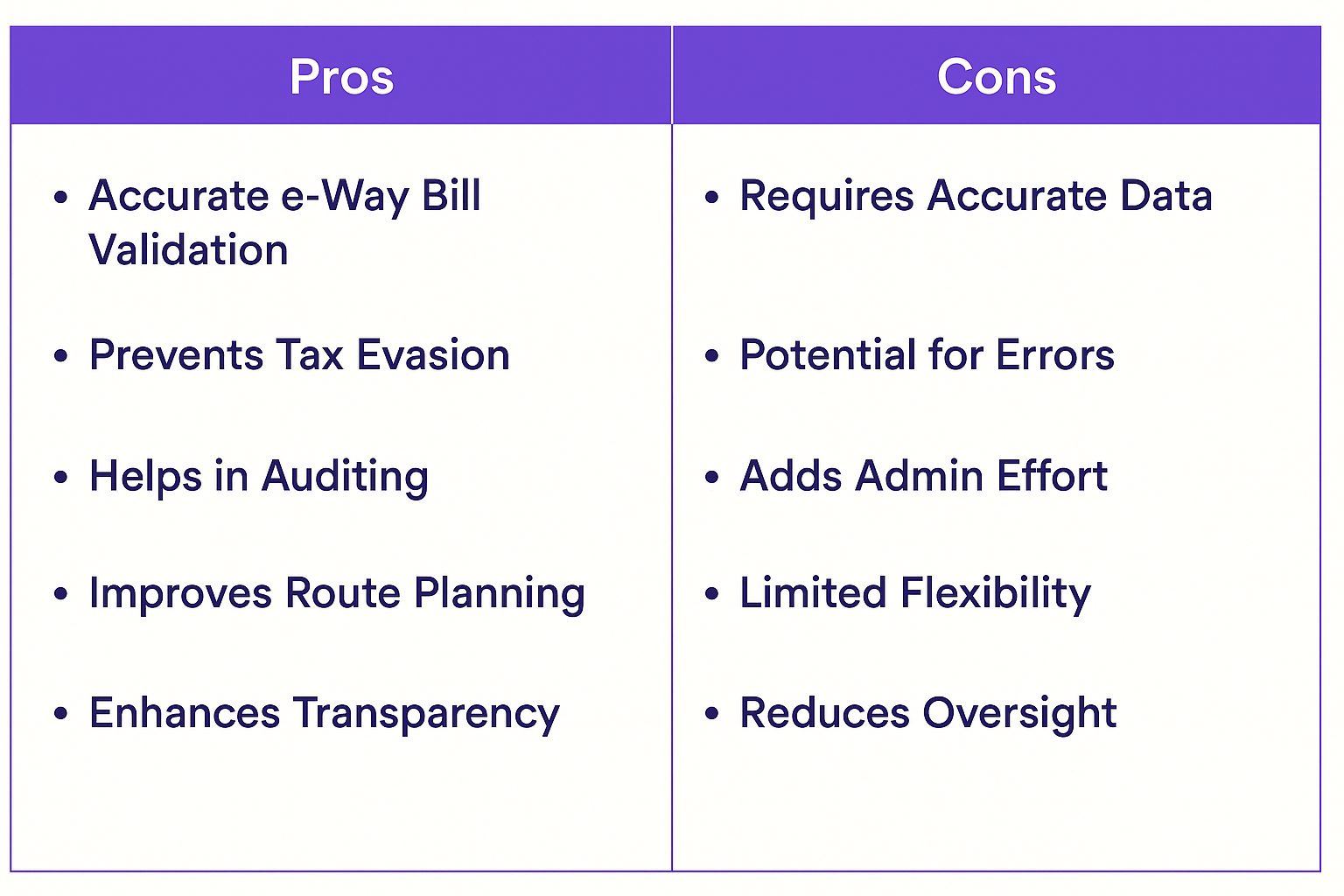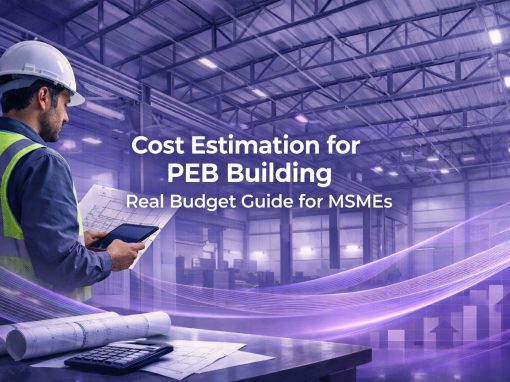Table of contents:
- Understanding Pin-to-Pin Distance in GST
- Importance of Pin-to-Pin Distance for e-Way Bills
- How to Calculate Pin-to-Pin Distance for GST Compliances
- Step-by-Step Guide to Using Pin-to-Pin Distance Tools
- Pros and cons of Using Pin-to-Pin Distance Calculators
- Tips to Ensure Accurate Distance Calculations
- Common Challenges and Practical Solutions
- Troubleshooting Errors in Distance Calculations
- Case Study: How Businesses Use Pin-to-Pin Distance for Logistics
- Conclusion
In the realm of Goods and Services Tax (GST) compliance, pin-to-pin distance plays a pivotal role in ensuring transparent and accurate e-way bill generation. This metric, measured between two PIN codes, plays a crucial role in determining the movement of goods across the country. By understanding the significance of pin-to-pin distance and its impact on e-way bill compliance, businesses can streamline their logistics operations and avoid potential penalties.
Importance of Pin-to-Pin Distance for E-Way Bills
The e-way bill is a mandatory document required for the interstate movement of goods valued at or above the prescribed threshold. It acts as a digital permit, enabling the seamless transportation of goods across state borders. The pin-to-pin distance between the origin and destination PIN codes is a key element in the e-way bill generation process. Here’s why:
- Accurate Calculation of E-Way Bill Validity: The validity period of an e-way bill is directly linked to the distance covered by the goods. A longer distance necessitates a longer validity period to ensure compliance.
- Preventing Tax Evasion: By accurately calculating the pin-to-pin distance, authorities can monitor the movement of goods and reduce the risk of tax evasion.
- Facilitating Audits: During audits, the pin-to-pin distance serves as a reference point to verify the authenticity of e-way bills and ensure that goods have been transported within the stipulated time frame.
- Guaranteeing Route Transparency and Planning: Pin-to-pin distance allows businesses to obtain a better understanding of their logistics by providing an accurate forecast of the route and duration of travel. This helps transporters improve the efficiency of growth of vehicle movements, better fuel consumption, and protection against delays, all of which are vital for on-time deliveries and cost containment.
- Reducing Disputes in Transit Checks: During transit checks, the most common issue is a discrepancy between the declared travel distance and the verified distance travelled. Since the exact pin-to-pin distance is recorded in the e-way bill, transporters can eliminate misunderstandings by offering credible records.
How to Calculate Pin Code to Pin Code Distance for GST Compliance
Calculating pin-to-pin distance is a relatively straightforward process. Here are the common methods employed:
- Online Tools and Calculators:
- Visit a government website or third-party application.
Click here for GST Portal - Enter the origin and destination PIN codes.
- Calculate the distance.
- Visit a government website or third-party application.
- GPS Devices:
- Use a GPS navigator or mobile app.
- Plot the route between the two locations.
- Obtain the distance.
- Mapping Services:
- Use a mapping service like Google Maps or MapMyIndia.
- Enter the origin and destination locations.
- Calculate the distance.
Pin to Pin distance Search Tool
Step-by-Step Guide to Using Pin-to-Pin Distance Tools
Step 1 –
Determine Origin and Destination PIN Codes: Identify the PIN codes of the places where the goods are originating from and going to. E.g., if your location is in Connaught Place, Delhi (pincode: 110001) and sending your goods to Khandari city located in Agra, Uttar Pradesh, then use (pincode: 223007)
Step 2 –
Calculate Pin-to-Pin Distance: Use the chosen method (online tool, GPS device, or mapping service) to calculate the distance between the two PIN codes.
Step 3 –
Generate E-Way Bill: Enter the calculated distance into the e-way bill generation portal. The system will automatically determine the validity period based on the distance.
Step 4 –
Ensure Accuracy: Double-check the calculated distance to avoid errors and ensure compliance.
Pros and Cons of Using Pin to Pin Distance for E-Way Bills
Tips to Ensure Accurate Distance Calculations
| Tip | Description |
|---|---|
| Use Reliable Tools | Opt for well-established and trusted tools for distance calculations. |
| Verify Results | Cross-check the calculated distance using multiple sources to ensure accuracy. |
| Consider Road Conditions | If the route involves specific road conditions (e.g., toll roads, detours), factor them into your calculations. |
| Stay Updated | Keep your mapping tools and GPS devices updated with the latest road information. |
Common Challenges and Practical Solutions
While Pin-to-pin calculators have made e-way bill generation easier, there are hurdles to overcome when we apply them to an actual logistics environment. Here are a couple of common issues companies face, and easy, practical solutions.
1. PIN Codes Can Differ in Coverage
Challenge: Some PIN codes cover large areas or rural locations, leading to different distance calculations.
Solution: Make sure you adequately verify the correct PIN code using the NIC portal and reconfirm by referring to the mapping tools.
2. Actual Route Can Differ from System Distance
Challenge: Road conditions like construction, diversion, or off-toll routes can vary from the calculated distance from the system.
Solution: Add a buffer (5-10%) while entering the distance. Or choose tools that integrate GPS with real-time routing instructions while filling out the e-way bill.
3. Different Tools Show Different Distances
Challenge: The same PIN pair can have different distances on the GST portal, Google Maps, or third-party calculators.
Solution: Pick a single source that your entire organisation agrees to use. Most businesses simply prefer to be compliant and choose the higher value.
4. Multi-Drop Deliveries Can Be Confusing
Challenge: When goods are shipped through hubs or dropped off at multiple locations, the single distance method can be misleading.
Solution: Break your trip into sections and create e-way bills for each section: start → warehouse → shop.
5. Manual Errors with PIN Entry
Challenge: If a simple typo is made in the PIN code, it can lead to incorrect distance, wrong validity, or rejected e-way bills.
Solution: Use dropdown boxes, auto-complete fields, or double-check PINs before submitting. Training your staff also goes a long way.
Pro Tip: Logistics technology that combines pin-to-pin calculation with e-way bill generation can eliminate most of these challenges automatically.
Troubleshooting Errors in Distance Calculation
| Issue | Solution |
|---|---|
| Incorrect PIN Codes | Double-check the PIN codes for accuracy. |
| Outdated Maps | Ensure that your mapping tools are using the latest data. |
| Traffic Congestion | Consider traffic conditions that may affect the travel time and distance. |
| Road Closures | Be aware of any temporary road closures or diversions that might alter the route. |
Case Study: How Businesses Use Pin-to-Pin Distance for Logistics
A Delhi-based FMCG company frequently ships products to retail stores across India. Previously, incorrect pin-to-pin distance calculations led to e-way bill expiration before delivery, resulting in penalties and delivery delays.
Solution Implemented:
- Used an AI-based distance calculator to get precise distances.
- Optimized delivery routes using Google Maps and GST-compliant tools.
- Integrated pin-to-pin distance calculations into their logistics management system.
- Prepare logistics personnel on typical PIN code errors to prevent manual entry errors.
- Created automated systems that alert to e-way bill expiry to achieve timely expiring renewals and uninterrupted delivery.
Results:
- 40% fewer e-way bill issues
- 15% reduction in logistics costs
- 100% GST compliance
Conclusion
Pin-to-pin distance is a crucial aspect of GST compliance, particularly for e-way bill generation. By accurately calculating and using pin-to-pin distance, businesses can ensure that their goods are transported within the stipulated time frame, avoid penalties, and maintain a transparent record of their logistics operations. By following the guidelines outlined in this article, businesses can streamline their GST compliance processes and optimize their logistics efficiency.
FAQs
Can I use approximate distance for e-way bills?
What happens if the actual distance traveled is different from the declared distance?
Is the pin-to-pin distance the only factor determining e-way bill validity?
What happens if an incorrect pin-to-pin distance is used?
Is this applicable if the distance is just 1 km away?
How do I calculate pin-to-pin distance for GST?
Why is the accurate pin-to-pin distance important for e-way bills?
Are there tools to automate pin-to-pin distance calculation?
What’s the maximum distance allowed per day for e-way bill validity?
Do I need separate e-way bills for multi-leg deliveries?
A product manager with a writer's heart, Anirban leverages his 6 years of experience to empower MSMEs in the business and technology sectors. His time at Tata nexarc honed his skills in crafting informative content tailored to MSME needs. Whether wielding words for business or developing innovative products for both Tata Nexarc and MSMEs, his passion for clear communication and a deep understanding of their challenges shine through.










In an invoice, showing the distance is compulsory for a service invoice? I offer digital service for organization from pan India, kindly advise.
I guess, it is important to highlight source and destination to showcase the validity of invoice.
for digital services, I don’t think it is needed, but yes, you will have to mention complete details about what is being sold and to whom its all details.
How do authorities ensure that the calculated pin-to-pin distance reflects the actual route taken, especially in cases where businesses may attempt to manipulate distances for shorter validity periods?
It reflects in the invoice itself. Source and Destination comparison helps in knowing the distance easily. Authority check the same thru GST portal online, when they find anything doubtful.
There are system in place for it, AI is also being introduced to faster and real-time updates. It can lead to penalties if used wrong/false information.